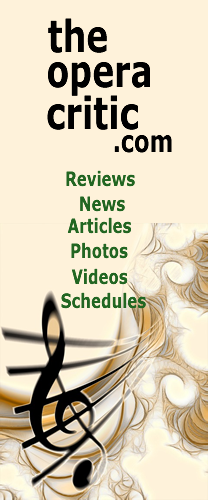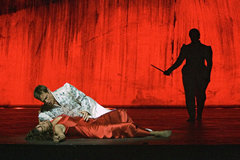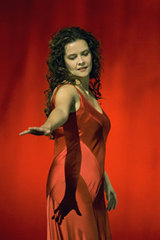| Opera Reviews | 19 April 2024 |
| Great
care lavished on the Royal Opera's Pelléas by Colin Anderson |
|
| Debussy: Pelléas et Mélisande The Royal Opera House, Covent Garden 11 May 2007 |
|
|
In his search for a new kind of French opera, Debussy looked to Wagner in his wish to write continuous music and in the use of leitmotifs, but the colours, expression and harmonies of Debussy's writing is recognisably 'French'. Debussy's operatic setting of Pelléas et Mélisande (a story that also attracted Fauré, Schoenberg and Sibelius) is regarded as something of a challenge - for performers, producers and listeners. Over five acts and 150 minutes or so of music, Debussy's ability to sustain a mostly slow pace is astonishing - through multifarious dynamic contrasts, subtle changes of colour and shifting harmonies that constantly divert the ear and paint pictures. Furthermore we find out all we need to know about the characters and their circumstances through the orchestra. When emotions become heated or violent, or when the oppressive atmosphere is gladdened by a chink of light or a breeze, this is meticulously sounded in the orchestra through brighter textures, quicker tempos or the use of fortissimo. The orchestra and the conductor are crucial to the success of Debussy's version of Pelléas et Mélisande. In the current production hosted by The Royal Opera (a co-production with the Salzburg Easter Festival) Sir Simon Rattle is a deeply sympathetic and perceptive interpreter of Debussy's discriminating yet revealing music. At this first night the inaugural sound to be heard, when the lights had lowered and Rattle was about to conduct, was the ringing of a mobile phone. Fortunately this stopped before the first music was heard. A beautiful, veiled sound emanated from the pit. We see the lone figure of Mélisande. She becomes very nervous of Golaud, who is also lost in the woods, as he enquires of her. Bit by bit they become closer. They marry and return to Golaud's family castle, a lonely and inhospitable place occupied by Geneviève (mother to Golaud and Pelléas), Arkel (the king), Yniold (Golaud's son) - and, of course, Pelléas himself. He is Golaud's half-brother, someone that Mélisande is unsure of, but their relationship grows, partly through innocence and naivety. Golaud has his bloody revenge at the end of Act IV when he stabs Pelléas to death - the violence all the more shocking for the restraint shown elsewhere. Debussy's opera is a study of the human condition, of relationships and feelings. A difficult work to stage, though, given there is little action beyond the revealing of the characters, their surroundings and their emotions. Under the direction of Stanislas Nordey, the production team has not tried to inflate anything nefarious to add 'entertainment'. Lighting is deliberately gloomy, save when extra brightness matches the text, and the stage is dominated by moveable gigantic tombstone-like designs that open up like trophy cabinets to display various collections of pertinent artifacts. In Act IV the stage is lit blood-red, a portent for the murder of Pelléas with which the act climaxes. An insular, hermetic world is well suggested. It is difficult to know what could be added. Similar effects could be achieved by other means and one can imagine different costumes for the castle inhabitants other than satin-white and bejeweled uniforms that seem more suitable for space travel than an earthly kingdom. |
|
|
The cast assembled by The Royal Opera is excellent. Each singer is in fine vocal form and each gives a vivid portrayal of their respective characters, believable as such (especially in allegorical terms). Special mention must be made of the youngest and oldest of the cast. George Longworth as Yniold (Golaud's son) is very confident of voice and movement, while Robert Lloyd (the king) brings a musical wisdom that is also apt for this role. This is an ensemble opera and this cast works well together. The foundation is the orchestra. The Orchestra of the Royal Opera House plays wonderfully well under Sir Simon Rattle who loves and respects this opera; he does not apply colours and sound, rather he illuminates from within Debussy's subtle variegation of texture and harmony, retaining elusiveness while making explicit the composer's wonderfully imagined musical and emotion-revealing processes. The very final chord, ending the still-death-haunted and uncertain last act and the opera as a whole, suggests the question of 'where next?'. The answer is to Covent Garden. Pelléas et Mélisande is a perplexing and enigmatic work, in many ways a masterpiece, certainly on purely musical achievements, but asks questions of opera itself and how best to stage it. The recorded broadcast on BBC Radio 3 on Saturday 9 June (at 6.30 p.m.) will present the opera as a feast for the mind. But the full staging is another way of unlocking the secrets. For the most part the first-night audience seemed to be compelled by the slow-burn beauty of Debussy's score and the splendid singing and acting. I'm not sure about the cart-wheeling lighting that presumably illustrates Mélisande unfurling her long hair (not seen as such) - another example of something being 'too much for the eyes' - but her appearance in the tower is well handled. In short, given the relative rarity of the opera and the care lavished on it here, then there is much that makes this a must-see (and -hear) production. |
|
| Photos:
© Clive Barda Text: © Colin Anderson |

 In
the October of 1893, Debussy started to plan an opera on the contemporaneous
'prose drama' Pelléas et Mélisande by Maurice Maeterlinck. Debussy
completed the score two years later but the opera was not heard until
30 April 1902 - a delay partly caused by Debussy's perfection-seeking
revisions and negotiations with the Opéra-Comique in Paris.
In
the October of 1893, Debussy started to plan an opera on the contemporaneous
'prose drama' Pelléas et Mélisande by Maurice Maeterlinck. Debussy
completed the score two years later but the opera was not heard until
30 April 1902 - a delay partly caused by Debussy's perfection-seeking
revisions and negotiations with the Opéra-Comique in Paris.  Debussy's
opera is more for the imagination and senses; for musical expression is
alone sufficient to get inside the characters and their particular world.
A recording of the work, or a concert performance, is ideal. (The gramophone
has been attracted to this opera over the decades; abridged recordings
started appearing in the 1920s and 1930s until Roger Désormière made a
complete version in 1941. Then conductors such as Abbado, Ansermet, Boulez,
Carewe, Cluytens, Haitink and Karajan have made the work easily available
to record collectors.) Staging it, this Royal Opera House one anyway,
can detract through being static and with little to watch, yet it also
underlines the nature of the work. A fine dividing line then between complementing
Debussy's intentions and swamping them. And, of course, seeing the singers
in character and through their gestures and interaction does add another
piece to the jigsaw.
Debussy's
opera is more for the imagination and senses; for musical expression is
alone sufficient to get inside the characters and their particular world.
A recording of the work, or a concert performance, is ideal. (The gramophone
has been attracted to this opera over the decades; abridged recordings
started appearing in the 1920s and 1930s until Roger Désormière made a
complete version in 1941. Then conductors such as Abbado, Ansermet, Boulez,
Carewe, Cluytens, Haitink and Karajan have made the work easily available
to record collectors.) Staging it, this Royal Opera House one anyway,
can detract through being static and with little to watch, yet it also
underlines the nature of the work. A fine dividing line then between complementing
Debussy's intentions and swamping them. And, of course, seeing the singers
in character and through their gestures and interaction does add another
piece to the jigsaw. 





